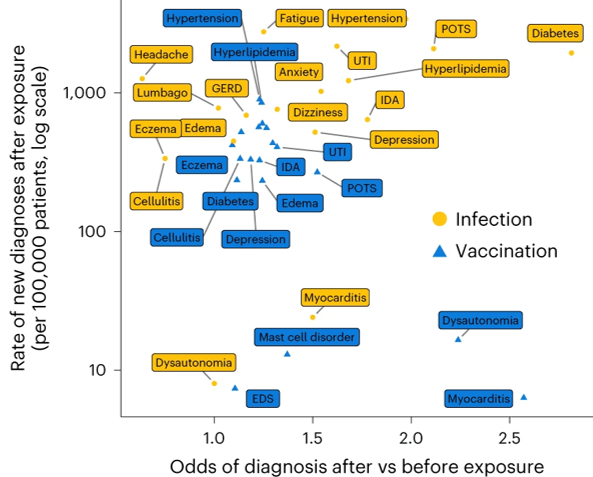
Misrepresents source (Strawman): Contrary to the claim, the researchers didn’t conclude that COVID-19 vaccines were associated with health problems. In fact, the authors and their research institution stated that vaccines are beneficial even in the light of these new results.

FULL CLAIM: “huge peer review show[ed] vaccines may have caused tens of millions of serious new health problems worldwide” ; “adults ha[d] sharply higher risks of being diagnosed with heart, skin, and psychiatric conditions for at least 90 days after they receive Covid jabs”
REVIEW
Scientific evidence from pre-authorization clinical trials and post-marketing monitoring established that COVID-19 vaccines’ benefits in preventing severe disease and death largely outweigh their possible risks.
However, inaccurate and biased interpretations of scientific studies about post-vaccination mortality and adverse event occurrences continue to feed the false narrative that these vaccines are dangerous and produce dangerous side effects. Previous reviews by Health Feedback explained why such claims were unsupported or the result of flawed data analysis.
A new iteration of such claims surfaced in late February 2023 when journalist Alex Berenson claimed on his Substack page that a “huge peer review show[ed] vaccines may have caused tens of millions of serious new health problems worldwide”, because “adults ha[d] sharply higher risks of being diagnosed with heart, skin, and psychiatric conditions for at least 90 days after they receive Covid jabs”. Berenson has published unsupported or inaccurate claims about COVID-19 and COVID-19 vaccines in the past.
Berenson’s claim is based on a study by Kwan and colleagues published in Nature Cardiovascular Research in December 2022[1], which monitored the likelihood of diagnosis of postural orthostatic tachycardia syndrome (POTS) during the three months prior and after COVID-19 vaccination or SARS-CoV-2 infection.
As we will explain below, Berenson’s account of the researchers’ work is incomplete and misleading.
POTS is a medical condition where the body has difficulty adjusting blood pressure when someone stands up from a lying down or sitting position. As a result, the person may experience a range of symptoms such as dizziness or fainting. While POTS isn’t dangerous per se, it can interfere with daily life. Risks of developing POTS are higher following certain medical events such as surgery or infections, including SARS-CoV-2 infection[2,3].
Confirming some previous reports[4,5], the study by Kwan et al. found that the likelihood of being diagnosed with POTS was slightly higher following COVID-19 vaccination than before—1.33 times higher. This is the result that Berenson used to support his claim.
However, Berenson omitted a critical part of the article’s results, namely that the likelihood of a POTS diagnosis was much higher following SARS-CoV-2 infection than after vaccination—5.33 times higher (Figure 1).

Figure 1. Odds of diagnosis. The odd ratio compares the odds of a diagnosis occuring in one situation relatively to another. An odd ratio of one thus means that the odds of diagnosis are equal in both situations. For the odd ratio calculation, the numerator is designated by the arrow, the denominator by the circle. For instance, the odds of a POTS diagnosis is 1.33 times higher post-vaccination relative to pre-vaccination, while the odds of POTS diagnoses post-COVID-19 is 5.35 times higher relative to the post-vaccination period. Adapted from Kwan et al.
The authors thus concluded:
“the rate of new POTS diagnoses made after vaccination was much less frequent [than] the rate of new POTS diagnoses made after SARS-CoV-2 infection, indicating that excess risks remain higher after infection than after vaccination.”
In an email to Health Feedback, Cedar-Sinai, the institution that the study authors are affiliated with, explained:
“The investigators also found that those diagnosed with COVID-19 are five times more likely to develop POTS after infection than after vaccination, emphasizing the importance of the vaccine. Study authors say the main message is that while there is a potential—not proven—link between COVID-19 vaccination and POTS, preventing COVID-19 through vaccination is still the best way to reduce the risk of developing POTS.”
Therefore, the results from Kwan et al. tell a completely different story than the interpretation offered by Berenson. People are more at risk of POTS following COVID-19 than vaccination, meaning that vaccination is actually the safest strategy to protect oneself from this condition.
Berenson’s claim is also misleading for other reasons. For example, Berenson claimed that vaccination increased the likelihood of other medical conditions such as hypertension, eczema and diabetes. The authors indeed included the odds of diagnosis post-vaccination or post COVID-19 for several medical conditions. However, this was intended as a way to measure the potential effects of people’s healthcare-seeking behavior on their odds of diagnosis.
This is important to study because getting vaccinated or getting COVID-19 may change how people behave, specifically, their tendency to seek healthcare. Such a change in behavior would affect the chance of being diagnosed before and after infection or vaccination, simply because people would seek more or less medical attention. In the authors’ own words:
“We also recognized that the exposure itself could influence healthcare behavior—for example, patients may feel more comfortable visiting physicians after vaccination.”
In other words, we cannot draw conclusions by only comparing the odds of POTS diagnosis before and after vaccination as it could be due to changes in healthcare-seeking behavior. We need to compare it to a reference. To circumvent this problem, the authors then monitored the number of diagnoses of common medical conditions:
“To this end, we compared the events of new diagnoses of POTS with new diagnoses of myocarditis (the benchmark event) and with new diagnoses of other conditions commonly made during primary care visits (referent events).”
The increase in POTS diagnosis was a real signal and not an artifact because the likelihood of POTS diagnosis increased more than the likelihood of diagnosis of other medical conditions.
This also means that looking at the odds of diagnosis of those common medical conditions pre- and post-vaccination as Berenson did isn’t informative as there’s no way to tell whether it’s a real signal or a consequence of a change in healthcare-seeking behavior.
Furthermore, Berenson misrepresented the odds of diagnosis of these other medical conditions. For instance, Berenson reported that there was a 23% increase in hypertension diagnosis post-vaccination (Table 1 from Kwan et al.). However, Berenson omitted to report that there was a 97% increase of hypertension diagnostic post-COVID-19 (Table 2 from Kwan et al.).
In fact, Kwan et al. showed that the increase in diagnoses was higher following infection than following vaccination for many medical conditions, and that the absolute rate of new diagnosis was also higher (Figure 2).

Figure 2. Odds of post-exposure diagnosis versus rate of new diagnosis per 100,000 for SARS-CoV-2 infection or COVID-19 vaccination. Diagnoses in yellow are from the cohort assessing the impact of COVID-19. Diagnoses in blue are from the cohort assessing the impact of vaccination. Adapted from Kwan et al.
In summary, the study by Kwan et al. showed that POTS is a possible but rare consequence of COVID-19 vaccination but also highlighted that COVID-19 itself was much more likely to cause POTS, demonstrating the benefits of vaccination. Claims that COVID-19 vaccines increased the odds of several medical conditions are based on a flawed and incomplete analysis of the study by Kwan et al. In particular, they ignored the fact that the study showed a person was much more likely to be diagnosed with several medical conditions after getting COVID-19 than after getting vaccinated.
REFERENCES
- 1 – Kwan et al. (2022) Apparent risks of postural orthostatic tachycardia syndrome diagnoses after COVID-19 vaccination and SARS-Cov-2 Infection. Nature Cardiovascular Research.
- 2 – Ormiston et al. (2022) Postural orthostatic tachycardia syndrome as a sequela of COVID-19. Heart Rythm.
- 3 – Fedorowski & Sutton (2023) Autonomic dysfunction and postural orthostatic tachycardia syndrome in post-acute COVID-19 syndrome. Nature Reviews Cardiology.
- 4 – Hermel et al. (2022) COVID-19 Vaccination Might Induce Postural Orthostatic Tachycardia Syndrome: A Case Report. Vaccines.
- 5 – Eldokla & Numan (2022) Postural orthostatic tachycardia syndrome after mRNA COVID-19 vaccine. Clinical Autonomic Research.


